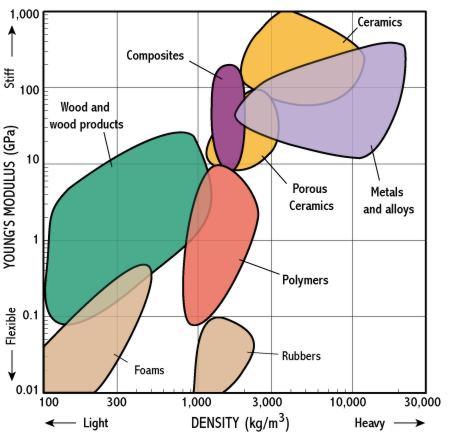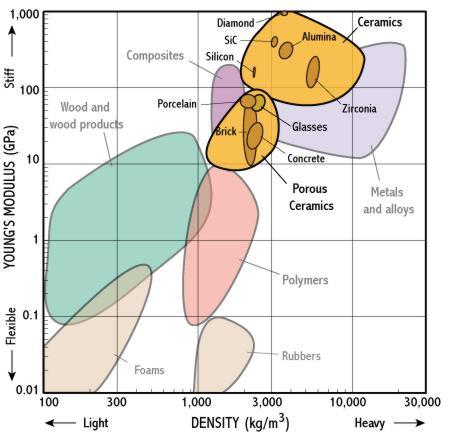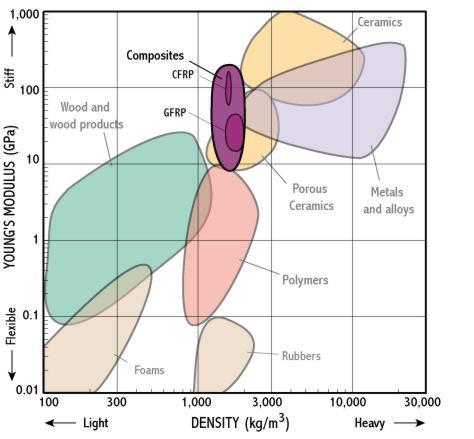Go to the basic non-Java version. Return to the charts main page
Young's Modulus - Density
Rollover class name to view individual materals, click chart to return to class view. Hover mouse over property for brief definition.
![]()








General Information
- 'Stiffness' measures how much something stretches when a load is applied. Young's modulus measures stiffness and is a material constant, i.e. it is the same whatever the size of the test-piece.
- Many applications require stiff materials, e.g. roof beams, bicycle frames - these materials lie at the top of the chart
- Many applications require low density materials, e.g. packaging foams - these materials lie to the left of the chart.
- Stiff lightweight materials are hard to find - composites appear to offer a good compromise, but they are usually quite expensive.
Physical Insights
- Both paper and MDF are made from wood pulp and so have similar densities and little directional variation in Young's modulus. Although we may think of paper as more floppy than MDF, this is because we find it in much thinner sections!
- The metal bubbles are quite small - this is because alloying does not have a significant effect on density or Young's modulus.
- Woods have very different stiffnesses depending on whether they are loaded 'with' or 'across' the grain. This is because of the stiff cellulose micro-fibres.
- Note how the materials all lie roughly on a diagonal - Young's modulus is strongly correlated to density.
- Foams have the lowest densities because they have pores full of air.
Example Uses
- Polymers don't seem like a good choice for stiff, lightweight products - but they can be reinforced by incorporating stiffeners into the design (for instance look inside a plug).
- Wood with the grain looks like a reasonable choice for light, stiff bike frames - but problems with mass production mean it is rarely used these days.
- Both wood and composites are used for oars - they both provide stiffness at relatively low weight. Composites are only used by professionals because they are expensive - a cost chart often needs to be used as well to get the full story.
- Since oars need to be light and stiff, why not use ceramics? Because they would probably break or crack! A strength chart often needs to be used as well as a stiffness chart to make a good selection.
Simple Questions
- Which polymers float?
- Why do brass and copper have similar properties?
- Why are designers trying to use composites in aircraft?
Further Questions
- What problems might there be in using wood for a bike frame?
- Wood, aluminium and composites have all been used for pole vaulting at various times - what makes them all suitable?
- Why might balsa be used in model-making? What other factors might you need to consider?
- Identify and discuss three examples combining light weight materials and shape for packaging.
- Why have both wood and steel been used for joists? What might affect your choice of wood?
There are 2 separate populations for this class to improve clarity. Move the mouse over different parts of the class name to reveal each one.
Select chart: